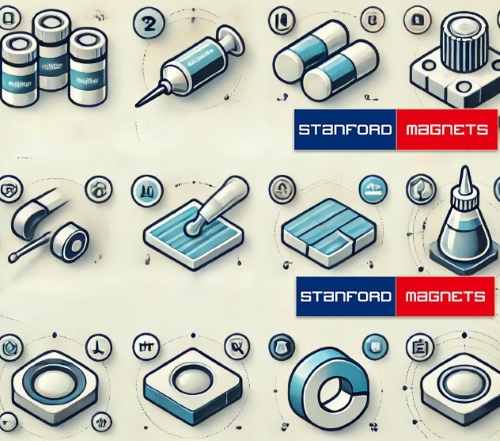Top 4 Adhesives for Magnets: Ensuring Secure Bonds
Introduction
Magnets play a vital role in various applications, from industrial machinery to everyday household items. To ensure these magnets remain securely in place, choosing the right adhesive is crucial. This article discusses the different types of adhesives suitable for magnets, their properties, and application tips to achieve the best results.

Types of Adhesives for Magnets
1. Epoxy Adhesives
– Properties of Epoxy Adhesives: Epoxy adhesives are renowned for their exceptional bonding strength and resistance to chemicals and temperature variations. They form a durable bond that can withstand demanding conditions.
– Applications of Epoxy Adhesives: These adhesives are ideal for industrial applications, particularly for bonding magnets to metals, plastics, and other surfaces that are exposed to harsh environments.
2. Cyanoacrylate Adhesives
– Properties of Cyanoacrylate Adhesives: Commonly known as super glue, cyanoacrylate adhesives provide a quick and strong bond. They are easy to use and cure rapidly.
– Applications of Cyanoacrylate Adhesives: These adhesives are suitable for small magnets and situations where a fast, reliable bond is needed, making them common in household and craft projects.
3. Acrylic Adhesives
– Properties of Acrylic Adhesives: Acrylic adhesives offer a good balance between flexibility and strength. They provide excellent resistance to environmental factors such as moisture and temperature changes.
– Applications of Acrylic Adhesives: Versatile in nature, acrylic adhesives are used for bonding magnets to plastics, metals, and ceramics, and are suitable for outdoor applications.
4. Polyurethane Adhesives
– Properties: Polyurethane adhesives are known for their flexibility and strong bonding capabilities. They have the ability to absorb shocks and vibrations.
– Applications: These adhesives are suitable for applications where the bonded materials might experience movement or vibrations, such as in automotive or electronic components.
5. Silicone Adhesives
– Properties: Silicone adhesives are flexible and resistant to moisture and extreme temperatures. They can handle expansion and contraction without losing adhesion.
– Applications: These adhesives are ideal for outdoor and marine environments, or in situations where thermal expansion is a concern.
| Adhesive Type | Key Properties | Primary Applications |
| Epoxy Adhesives | High bonding strength, chemical, and temperature resistance | Industrial applications, bonding magnets to metals and plastics in harsh environments |
| Cyanoacrylate Adhesives | Fast curing, strong bond | Small magnets, household, and craft projects |
| Acrylic Adhesives | Balance of flexibility and strength, environmental resistance | Bonding plastics, metals, and ceramics, suitable for outdoor applications |
| Polyurethane Adhesives | Flexible, shock and vibration absorption | Automotive and electronic components where movement occurs |
| Silicone Adhesives | Flexible, moisture and temperature resistance | Outdoor and marine environments, thermal expansion concerns |
For more information, please check Stanford Magnets.
Application Tips
To achieve the best results when bonding magnets with adhesives, follow these guidelines:
- Surface Preparation: Clean both the magnet and the surface thoroughly to remove any dust, oil, or contaminants. Use a solvent like alcohol for cleaning. Lightly sanding the surfaces can also improve adhesion by creating a rough texture for the adhesive to grip.
- Adhesive Application: Apply a small amount of adhesive evenly on the magnet and the surface. Ensure there are no air bubbles trapped in the adhesive layer, as they can weaken the bond.
- Clamping: Once the adhesive is applied, press the magnet firmly onto the surface and use clamps or weights to hold it in place. This ensures even pressure and a strong bond.
- Curing Time: Follow the manufacturer’s instructions for curing time. Do not disturb the bond during this period to ensure maximum strength. Curing times can vary from a few minutes for cyanoacrylate adhesives to several hours for epoxies.
Further reading: Coatings & Adhesives of Neodymium Magnets
Conclusion
Selecting the right adhesive for magnets is essential. Epoxy adhesives provide strength and durability for industrial applications, while cyanoacrylate adhesives offer quick and easy solutions for smaller projects. Acrylic, polyurethane, and silicone adhesives each bring unique properties that cater to specific needs, such as flexibility, environmental resistance, and handling of vibrations.
Proper surface preparation and application techniques are crucial for maximizing the effectiveness of the adhesive. By understanding the properties and best uses of each adhesive type, you can ensure that your magnets stay securely in place, no matter the application.